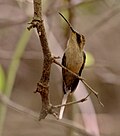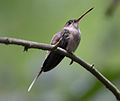| Image | Common name | Scientific name | Distribution |
|---|
 | Dusky-throated hermit | Phaethornis squalidus | Atlantic Forest in south-eastern Brazil. |
 | Streak-throated hermit | Phaethornis rupurumii | south-eastern Venezuela, west-central Guyana, and the extreme northern Brazil Amazon Basin |
 | Tapajós hermit | Phaethornis aethopygus | south-eastern Amazon in Brazil |
 | Little hermit | Phaethornis longuemareus | north-eastern Venezuela, northern Guyana, Suriname, French Guiana and Trinidad. |
 | Minute hermit | Phaethornis idaliae | humid Atlantic Forest in south-eastern Brazil, ranging from Rio de Janeiro north to south-eastern Bahia |
 | Cinnamon-throated hermit | Phaethornis nattereri | Amazon Rainforest from far north-eastern Bolivia north-east to Maranhão in Brazil. |
 | Black-throated hermit | Phaethornis atrimentalis | western Amazon in Colombia, Ecuador, and Peru |
 | Stripe-throated hermit | Phaethornis striigularis | southern Mexico, Central America, Tumbes–Chocó–Magdalena to Cordillera de Mérida and Venezuelan Coastal Range ; Sierra Nevada de Santa Marta |
 | Grey-chinned hermit | Phaethornis griseogularis | Colombia, Ecuador, Peru, Venezuela, and - marginally - far northern Brazil |
 | Reddish hermit | Phaethornis ruber | Bolivia, Brazil, Colombia, Ecuador, Peru, Venezuela, and in the Guianas. |
 | White-browed hermit | Phaethornis stuarti | Bolivia and Peru. |
 | Buff-bellied hermit | Phaethornis subochraceus | Bolivia and Brazil. |
 | Sooty-capped hermit | Phaethornis augusti | Venezuela, Colombia, Guyana and Brazil |
 | Planalto hermit | Phaethornis pretrei | eastern and south-central Brazil, eastern Bolivia, Paraguay, and marginally in north-western Argentina. |
 | Scale-throated hermit | Phaethornis eurynome | north-eastern Argentina, south-eastern Brazil, and eastern Paraguay |
 | Pale-bellied hermit | Phaethornis anthophilus | Colombia, Panama, and Venezuela |
 | White-bearded hermit | Phaethornis hispidus | Bolivia, Brazil, Colombia, Ecuador, Peru, and Venezuela. |
 | White-whiskered hermit | Phaethornis yaruqui | Colombia and Ecuador. |
 | Green hermit | Phaethornis guy | southern Central America (Costa Rica and Panama) south to northern South America (north-eastern Venezuela and Trinidad, and the northern Andes of eastern Peru) |
 | Tawny-bellied hermit | Phaethornis syrmatophorus | Colombia, Ecuador, and Peru |
 | Koepcke's hermit | Phaethornis koepckeae | Peru. |
 | Needle-billed hermit | Phaethornis philippii | western Brazil, Peru and northwestern Bolivia |
 | Straight-billed hermit | Phaethornis bourcieri | Guyanas of Guyana, Suriname, and French Guiana; also the northern Amazon basin of Brazil, and Amazonian Colombia, Ecuador, and Peru |
 | Long-billed hermit or western long-tailed hermit | Phaethornis longirostris | central Mexico south to northwestern Colombia, extreme western Venezuela and western Ecuador. |
 | Mexican hermit | Phaethornis mexicanus | Mexico |
 | (Eastern) long-tailed hermit | Phaethornis superciliosus | Venezuela, the Guianas, and north-eastern Brazil. |
 | Great-billed hermit | Phaethornis malaris | Bolivia, Brazil, Colombia, Ecuador, French Guiana, Peru, Suriname, and Venezuela. |
|


































